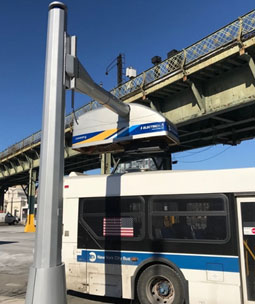EPRI Examines How Best to Deploy Fast, Widespread Electric Vehicle Charging
Today’s electric vehicles (EVs) can handle most of people’s daily driving needs—relatively short commutes and trips to the store or school. But for EVs to go fully mainstream, some believe that they must meet demands for less frequent, long-distance driving, such as a 4-hour drive to grandma’s for Thanksgiving or road trips to national parks.
“You don’t just buy a car for your commute,” said John Halliwell, a technical executive in EPRI’s Electric Transportation Group. “If you want a broad base of customers, you need to meet more of their needs, including traveling long distances.”
More public charging stations are needed so that drivers don’t fret about getting stranded far from home. Charging must be fast enough to approximate the experience of filling up at a gas station. What constitutes “fast” charging may vary among customers, though a rule of thumb, based on a consensus of automakers, is charging 50–80% of a battery’s capacity in 10 to 30 minutes—enough time to get a coffee and stretch.
With utilities, automakers, and charging equipment manufacturers, EPRI is leading discussion and collaborative research to develop charging that is fast, widespread, cost-effective, satisfies driver demands, and supports reliable grid operations. Three times a year, EPRI’s Infrastructure Working Council convenes these stakeholders to address key questions and technical challenges. EPRI also coordinates working groups focused on electric bus and truck issues, direct current (DC) charging services, and utility vehicle fleets.
One question under discussion in the infrastructure group involves capacity. Today’s public charging stations typically have a 50-kilowatt capacity, which can give a battery with a 100-mile range an 80% charge in 30 to 40 minutes. As EV batteries get larger, stations need much greater capacity for fast charging. EPRI is planning research over the next five years to address capacity requirements.
Even as significant investment will be required to expand high-power public charging infrastructure, it must be considered that most EV charging will likely be done overnight at home. “Because you can charge at home, and cars get more and more range, you don’t need as much high-power public charging as you may initially assume,” said Dan Bowermaster, program manager of EPRI’s Electric Transportation Group. “That being said, what consumers need and what they want are two very different things.”
Another question: how can charging stations supply the considerable load necessary to charge multiple vehicles simultaneously. For example, municipalities deploying electric bus fleets must plan ahead.
“Electric buses don’t draw steady power. They need 300 kilowatts for 10 minutes a few times a day. It’s a challenging load for a utility and impacts local power quality,” said Halliwell. “Serving a municipal fleet of buses will require a large infrastructure capacity, but the total energy use is likely to be less than that of a typical commercial customer with the same capacity.”
“Thanks to the collaborative infrastructure group, bus makers and other vehicle makers better understand that they can’t come to a city and ask for one megawatt of power to be installed on this corner in two weeks,” said Bowermaster. “They understand the need for upfront discussion with the utility about where and how to site charging capacity along bus routes.”

A demonstration project with the New York Power Authority (NYPA) in New York City is underway to better understand these issues. NYPA and EPRI are installing enough on-route and depot chargers to keep 10 electric buses charged. Based on initial data on bus performance, energy consumption, and charger installation and operational costs, EPRI and NYPA will formulate a plan to deploy additional electric buses and charging infrastructure cost-effectively.
New standards are needed to enable widespread, fast public charging stations. EPRI staff chair two Society of Automotive Engineers committees that are developing standards for the connectors that link EV batteries to sources of electricity.
“Certain brands of chargers may not work with certain brands of buses because of connector incompatibility,” said Halliwell. “Standards can eliminate such scenarios.”
In 2018, EPRI will survey utility customers to examine their motivations for EV purchases and expectations regarding public charging infrastructure. High-power charging stations are expensive, and most drivers will use them only occasionally. At the same time, the lack of a robust network could dampen EV demand.
“An expensive public charging infrastructure may be needed for people to buy EVs, but they might not use it much,” said Halliwell. “We are looking to find the right balance between investment and driver perception. We have to get past the point where charging stations are so rare that you need a map to find them.”
How Does Widespread EV Charging Affect Grid Operations?
To help utilities manage an influx of EVs, EPRI developed a “hotspotter” tool that can model the impacts of various EV penetration levels on distribution circuits down to the transformer level. It compares nameplate ratings of transformers against EV charging load over time.
“Contrary to what one might think, EVs won’t impact the grid anytime soon,” said Dan Bowermaster, program manager of EPRI’s Electric Transportation Group. “Utilities are very good at maintaining a safe, reliable grid. In most cases, the challenge is more about how to integrate charging load into grid planning rather than how to maintain reliability.”
Key EPRI Technical Experts:
John Halliwell, Dan Bowermaster
Additional Resources:
- Program on Technology Innovation: EVS30 Symposium—Stuttgart, Germany, October 9–11, 2017: Vision for and Implementation of a National High-Power DC Fast Charging Network
- Pepco Demand Management Pilot for Plug-In Vehicle Charging in Maryland: Final Report—Results, Insights, and Customer Metrics


